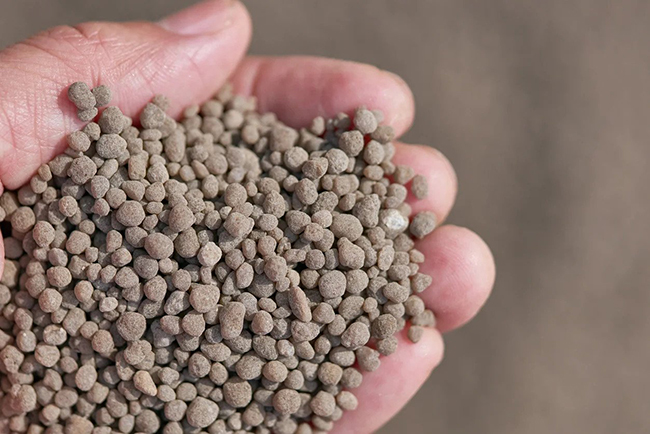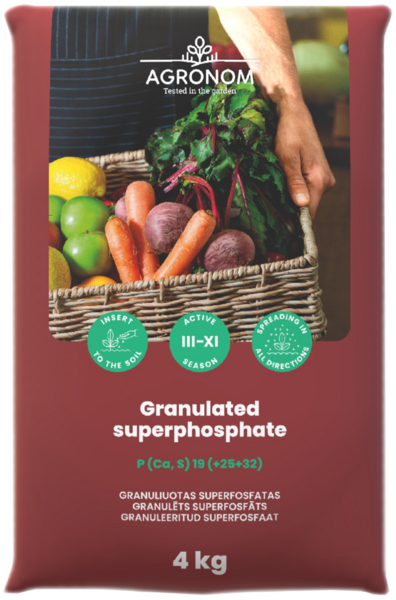Superphosphate is a very effective fertilizer.
Phosphorus-based fertilizer can act in several ways:
- improvement of the root system of plants
- maintaining or restoring the healthy development and growth of the plant
- increase in yields
- improving the quality of the crop (for example, there is a higher protein content in cereals and oilseeds, rapeseed, soybeans)
- slowdown of oxidative processes and strengthening of recovery processes in the soil.
Superphosphate contains: phosphorus, calcium, sulfur, nitrogen and magnesium:
* Sulfur is especially valuable in the cultivation of legumes, grains and oilseeds.
* Calcium neutralizes soil acidity.
* Magnesium is indispensable in farms focused on growing potatoes.
Superphosphate fertilizer is offered to the consumer in the form of powder and in the form of granules (moreover, the powder version is much cheaper than the granular one,
but less effective in a number of applications).
Although for the preparation of composts, it is the powder version that is recommended due to easier mixing and dissolution with other ingredients of complex organo-mineral mixtures.
Application methods: it is desirable to apply the main part during autumn (spring) digging to the depth of tillage (April, September);
when sowing or planting (preferably granular) - in holes, grooves, pits (May); as top dressing (June, July, August).
The dosage of superphosphate depends not only on the type of plant, but also on the quality of the soil. For example, for vegetables and herbs, it is recommended to apply from 30 to 40 g per 1 m2 of soil.
If the soils are poor, then the fertilizer dosage should be increased by 20-30%.
Superphosphate can not be dug up, mixed with the soil, but simply scattered evenly over the planting area, strictly observing the dosage (indicated on the package).
Application.
Superphosphate is suitable for use on all types of soil and for all crops. But on acidic soils, it is difficult for plants,
therefore, it should be deoxidized with dolomite flour, lime or ash: add 0.2 kg of ash or 0.5 kg of slaked lime per 1 m2.
Remember that superphosphate can be applied to the soil no earlier than a month after deoxidation, otherwise it will lose most of its useful properties.
Superphosphate is applied to the soil before sowing plants during digging, poured directly into the holes (rows) immediately before planting,
it is used as top dressing (see the proportion for different horticultural crops on the package).
Important! When using superphosphate, do not forget the axiom: never mix it with urea, lime, ammonium nitrate and chalk!

Due to the fact that granules dissolve slowly both in water and in soil, the effect of granulated fertilizer is longer, reaching several months (granulated superphosphate is most often used for cruciferous, legume, cereal and bulbous crops).
Superphosphate can be added to compost, added to the soil when making beds or holes, added to the soil in the fall when digging it, scattered over the surface of the soil or even on the snow, or dissolved in water and used as foliar feeding.
It is most effective to apply this fertilizer in the fall, so as not to create an excess, since over the winter the fertilizer will pass into the most accessible form for plants, and in the spring, cultivated plants will take from the soil as much substances as they need.
Usually, 45 g per square meter of soil is added during digging in the fall (in the spring, this amount can be reduced to 40 g). On very poor soils, the amount of this fertilizer can be increased to 30%.
When adding to humus, 10 g of superphosphate is added to 10 kg.
When planting potatoes or vegetable crops at the seedling age in a permanent place, it is advisable to add about half a teaspoon to each hole.
When planting shrubs, it is advisable to add 25 g of fertilizer to each planting hole, and when planting fruit trees - 30 g of this fertilizer.
Superphosphate granules dissolved in water are usually used in the spring: it is no secret that in this way nutrients penetrate the plants as quickly as possible, but you should know
that granulated superphosphate dissolves very poorly in cold and hard water.
To dissolve it, you need to use soft water (ideally - rainwater), pouring boiling water over the granules (for example, 1 liter). Only then mix this concentrate with the required volume of water (if there is no need to rush, then the fertilizer can be placed in a dark-colored container, putting it in a sunny place - and in 2-3 hours the granules will dissolve safely).
In order not to dissolve the fertilizer each time, you can prepare a concentrate, for which you should pour 350 g of fertilizer with three liters of boiling water.
It remains to stir the resulting composition for a quarter of an hour so that the granules dissolve as completely as possible.
Before use, this concentrate should be diluted at the rate of: 100 g of concentrate per 10 liters of water (when fertilizing the soil in the fall, it is advisable to add 450 g of wood ash to this concentrate).
Superphosphate for fruit plants. It is usually added in the spring, one tablespoon of this fertilizer is used for each seedling.
It is also acceptable to add it when planting a seedling in planting holes, 100 g of this fertilizer should be poured into each hole, thoroughly mixing it with the soil.
When adding such an amount of superphosphate when planting seedlings during the year, there is no point in fertilizing with this fertilizer.
Approximately in the middle of the season, superphosphate can be applied again under adult trees. During this period, 80-90 g of superphosphate should be added to the trunk strip for each tree.
Superphosphate for tomatoes. Superphosphate should be applied to tomatoes twice a season, usually the first time it is applied when planting seedlings, and the second time - during the flowering of tomatoes.
When planting, 15 g of fertilizer is placed in the hole, thoroughly mixing it with the soil. During the time interval when tomatoes are blooming, you need to fertilize the crop with fertilizer diluted in water.
Superphosphate for potatoes. Usually, granulated superphosphate is added to the hole when planting potatoes, adding 10 granules to each hole, mixing them with the soil.
Superphosphate for cucumbers. Superphosphate is added to cucumbers twice. The first feeding is carried out a week after planting the seedlings, at this time 50 g of superphosphate dissolved in 10 liters of water per 1 m2 are added. The second time during the flowering period, 40 g of superphosphate is added, also dissolved in a bucket of water - also per square meter of soil.
Superphosphate for garlic. This is done a month before planting garlic, combining feeding with digging the soil, using 30 g of superphosphate per 1 m2. If the plants have a phosphorus deficiency, then in summer it is also permissible to fertilize the garlic, for which 40 g of superphosphate should be diluted in a bucket of water and this solution
spray the aboveground mass of garlic, wetting it well.
Superphosphate for grapes. Usually, superphosphate is applied to this crop once every two years.
Apply 50 g of superphosphate at the height of the season, which is embedded in moist soil to a depth of 25-30 cm.
Superphosphate for garden strawberries. Apply when planting seedlings. The amount of superphosphate for each hole is 10 g.
Superphosphate can also be applied in dissolved form, for which 30 g of fertilizer is dissolved in 10 liters of water (the norm for each hole is 250 ml of solution).
Superphosphate for raspberries. Apply in the fall: in early or mid-September at the rate of 50 g per square meter.
To apply it, make small depressions about 15 cm deep, retreating 30 cm from the center of the bush.
Also fertilize the soil by placing the fertilizer in trenches during planting of raspberry seedlings. Add 70 g of superphosphate to each hole, mixing it well with the soil.
Superphosphate for apple trees. It is better to apply granulated superphosphate to apple trees in the fall at the rate of 35 g per square meter of the trunk circle
into previously loosened and well-moistened soil. On average, 3 to 5 kg of superphosphate is applied to each apple tree.
Superphosphate is a useful and popular fertilizer for plants, and, due to its prolonged action, the effect of its application lasts for many years.











